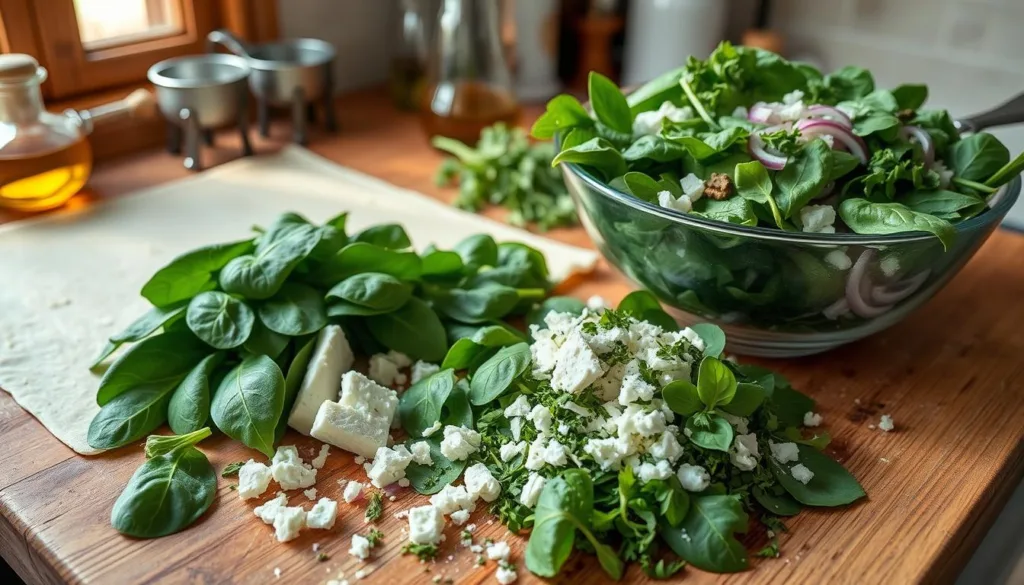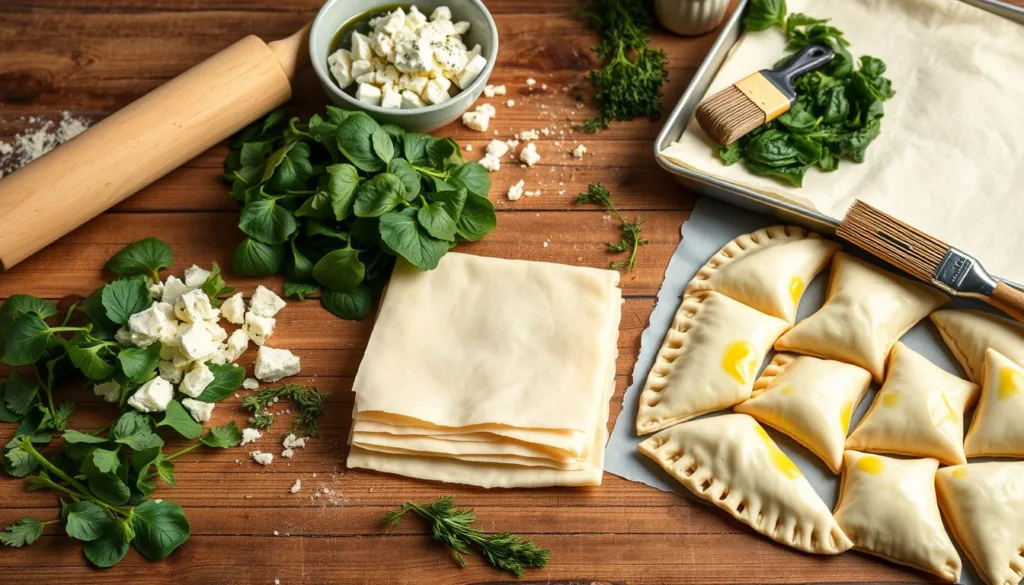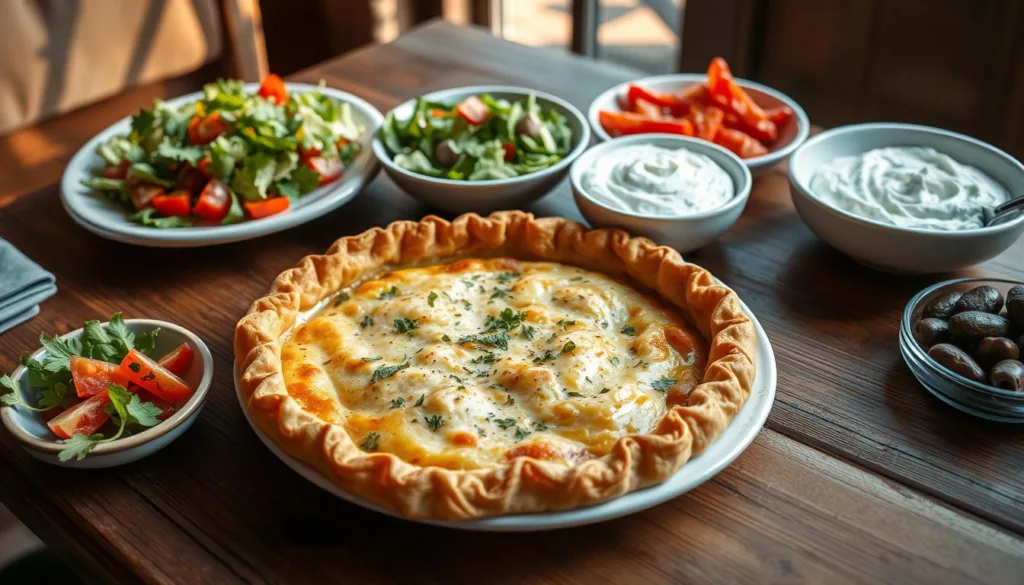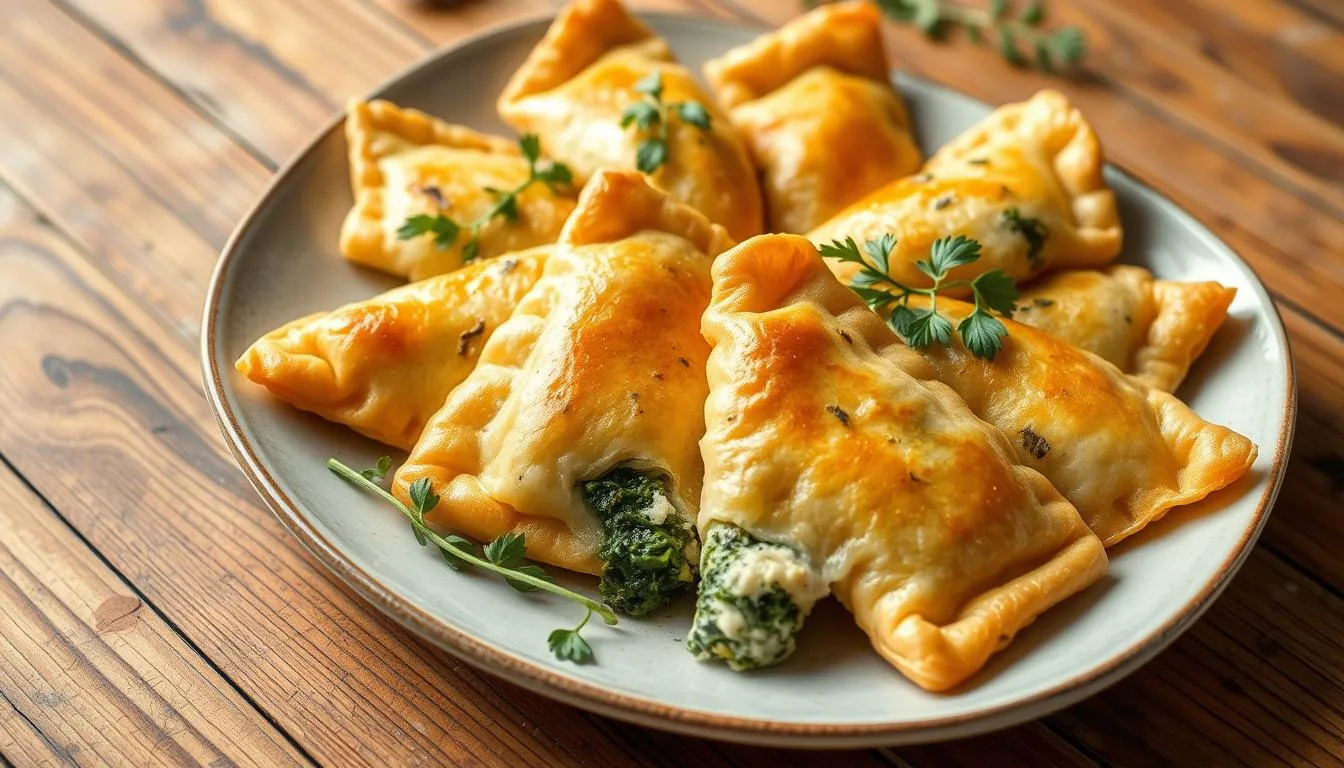The smell of Greek spinach pie baking in my kitchen takes me back to Athens. Every flaky layer of this traditional spanakopita shares a story of Greek cooking. It invites you to try the rich flavors of Greece in your own kitchen.
Making homemade phyllo dough might seem hard, but it’s worth it. This spanakopita recipe will show you how to make a delicious dish. It celebrates the simple yet powerful ingredients of Greek cooking.
From the thin layers of homemade phyllo to the creamy feta cheese and spinach, every bite is a trip to the Mediterranean. Get ready to turn your kitchen into a Greek grandmother’s kitchen.
Key Takeaways
- Master the art of making authentic Greek spanakopita from scratch
- Learn traditional phyllo dough preparation techniques
- Understand the importance of fresh ingredients in Greek cuisine
- Discover how to create perfectly crispy and flavorful layers
- Explore the cultural significance of this beloved Greek dish
What is Spanakopita: Understanding the Greek Spinach Pie
Spanakopita is a key part of Greek cuisine, a tasty pie that shows off Mediterranean cooking. It turns simple ingredients into a dish loved for ages.
The name spanakopita comes from Greek words: “spanaki” for spinach and “pita” for pie. It’s a great example of how Greek cooking makes simple things special.
Origins and Cultural Significance
Spanakopita has deep roots in Greek cooking history. It’s a key part of the Mediterranean diet. Farmers and cooks made it with fresh spinach and feta cheese, making a tasty and healthy meal.
- Originated in rural Greek communities
- Represents resourceful cooking techniques
- Embodies the farm-to-table philosophy
Traditional Ingredients Overview
A traditional spanakopita uses simple but key ingredients. The main parts are:
- Fresh spinach
- Creamy feta cheese
- Delicate phyllo dough
- Fresh herbs like dill
- Eggs for binding
“Spanakopita is not just a dish, it’s a story of Greek culinary tradition wrapped in crispy layers of phyllo.” – Greek Culinary Expert
Regional Variations in Greece
Greece has its own spin on spanakopita. Some places add leeks for flavor, while others use local cheeses. This shows the variety in Greek cooking.
Spanakopita is loved as street food, breakfast, or part of a big meal. It’s a dish that shows the heart of Greek cooking.
Essential Ingredients for Perfect Spanakopita
To make a real spanakopita, you need the right ingredients. These ingredients bring out the rich flavors of this classic Greek dish. Your journey to a perfect spinach pie starts with understanding the key components that make spanakopita truly exceptional.
Phyllo Dough Essentials
The foundation of any great spanakopita is its delicate phyllo dough. You’ll need 2 pounds of #4 phyllo pastry, kept at room temperature to ensure easy handling. Melted butter is crucial – prepare 1 pound to brush between layers, creating those signature crispy, golden sheets.
Spinach and Cheese Blend
- Fresh spinach: 1 pound or 3 bunches, finely chopped
- Feta cheese: 1 pound, crumbled for authentic Greek flavor
- Ricotta cheese: 15 ounces of full-fat variety
- Scallions: 6, thinly sliced for added depth
Flavor Enhancers
Elevate your spanakopita with these key ingredients:
| Ingredient | Quantity | Purpose |
|---|---|---|
| Fresh Dill | 2 bunches (or 2 tsp dried) | Adds bright, herbal notes |
| Eggs | 4, room temperature | Binds filling together |
| Olive Oil | 1 tablespoon | Enhances richness |
| Salt | 1/2 teaspoon | Balances flavors |
“The secret to an authentic spanakopita lies in the quality of your ingredients and the love you put into preparing them.” – Greek Culinary Tradition
When selecting feta cheese, opt for authentic Greek varieties made from sheep’s milk. The traditional ratio is 1 part feta to 3-5 parts spinach filling, ensuring a perfect balance of flavors.
Pro Tip
For those short on time, frozen spinach works well. Just be sure to thoroughly drain and squeeze out excess moisture to prevent a soggy filling. Your spanakopita will thank you with its crisp, golden exterior and creamy, flavorful interior.
Preparing the Phyllo Dough From Scratch
Making homemade phyllo is an art that turns simple ingredients into flaky, delicate layers. It needs patience, skill, and a deep understanding of Greek pastry techniques.
- 300g hard wheat flour
- 50g durum wheat flour
- 50g extra virgin olive oil
- 15g white wine vinegar
- 9g sea salt
- 9g baking powder
- 207g warm water
Making the Dough Base
To start, mix the dry ingredients in a large bowl. Make a well in the center and add the wet ingredients slowly. Knead until it’s smooth and elastic, which takes about 5-7 minutes.
Rolling and Layering Techniques
The secret to flaky layers is in your rolling technique. Divide the dough into 8 parts and roll each into a thin circle. Precision is key – aim for dough so thin you can see through it.
“Phyllo dough is not about perfection, but about passion and practice.” – Greek Pastry Master
Tips for Working with Fresh Phyllo
Working with fresh phyllo needs a gentle touch. Keep the dough covered with a damp cloth to prevent drying. Brush each layer with olive oil or melted butter for those crisp, delicate layers that make Greek pastry irresistible.
- Rest the dough for 1 hour before rolling
- Work quickly to prevent drying
- Use a light touch when handling
- Keep unused dough covered
Creating the Spinach and Feta Filling

Making the perfect Greek spinach filling is an art. It turns simple ingredients into a delicious spanakopita. The key is in the feta cheese mixture and herb seasoning.
To start, pick fresh spinach as the base. Here’s what to do next:
- Sauté chopped leeks and green onions in olive oil until soft
- Add spinach and cook until it’s all wilted (about 5 minutes)
- Drain out any extra moisture to avoid a soggy pie
The secret to a true Greek spinach filling is finding the right balance of flavors. Mix in crumbled feta cheese into the cooled spinach. Fresh herbs are key – add chopped dill and parsley to bring out the Mediterranean taste.
“A great spanakopita is all about the quality of its filling” – Greek Culinary Tradition
To make the feta cheese mixture perfect, add eggs as a binder. Season with salt and pepper, adjusting the taste as needed. Let the mixture cool before adding eggs to avoid scrambling.
- Use fresh eggs for the best taste
- Mix ingredients gently to keep the texture right
- Make sure the filling is well-drained
Your Greek spinach filling is now ready. It’s time to make an authentic spanakopita that will take your taste buds to the Mediterranean!
The Art of Layering Phyllo Sheets
Mastering phyllo layering is key to making perfect spanakopita. The delicate process of butter brushing and precise sheet placement turns simple ingredients into a crispy pastry masterpiece.
When working with phyllo dough, precision is crucial. Your goal is to create multiple thin, delicate layers. These layers will transform into a golden, crispy exterior.
Proper Buttering Techniques
Butter brushing is vital for achieving that flaky texture. Use these techniques to elevate your spanakopita:
- Melt unsalted butter at room temperature
- Use a soft pastry brush for even application
- Brush each phyllo sheet gently but thoroughly
- Apply butter in light, consistent strokes
Preventing Phyllo from Drying
Phyllo dough is very sensitive to air. Protect your sheets with these methods:
- Cover unused phyllo with a damp cloth
- Work quickly and efficiently
- Keep a spray bottle of water nearby
- Handle sheets with clean, dry hands
Creating Crispy Layers
Achieve restaurant-quality crispy pastry with these expert tips:
| Technique | Purpose |
|---|---|
| Layer Arrangement | Use two-thirds of phyllo sheets for bottom layer |
| Air Trapping | Ruffle sheets to create air pockets |
| Top Layer | Fold and brush with extra butter |
“The secret to perfect spanakopita lies in the delicate dance of phyllo layers and butter.” – Greek Culinary Tradition
Remember, practice makes perfect. Each time you make spanakopita, your skills will get better. You’ll make more delicious and crispy pastries.
Step-by-Step Assembly Process
Mastering spanakopita assembly needs precision and care. Start by picking the right baking dish and setting up your workspace. A 13×9-inch rectangular pan is ideal for a classic Greek spinach pie.
Your layering technique is key to the pie’s texture and taste. Begin by brushing the baking dish with olive oil. This prevents sticking and gives a golden base.
- Lay out two-thirds of your phyllo sheets in the bottom of the pan
- Brush each sheet with olive oil or melted butter
- Spread the spinach and feta filling evenly across the layers
- Cover with remaining phyllo sheets
- Tuck edges neatly into the sides of the pan
Pro tip: Score the top layer with a sharp knife, making diamond or triangle patterns. Be careful not to cut through to the filling. A light sprinkle of water before baking helps achieve an extra crispy crust.
“The secret to perfect spanakopita lies in the delicate balance of layers and filling” – Greek Culinary Tradition
Your pie will yield 15 appetizer-sized triangles or 10 main course portions. Preparation takes about 30 minutes, with baking taking around 36 minutes.
Remember, practice makes perfect with phyllo sheets. Each time you make spanakopita, your technique will get better. This brings you closer to an authentic Greek culinary experience.
Baking Tips for Golden Crispy Results
To get the perfect golden brown pastry, you need to be precise and careful. Your goal is to make a crispy phyllo that looks and tastes great. Here are some expert tips to make your Greek spinach pie amazing.
When baking spanakopita, temperature and timing are key. They help create that crispy exterior everyone loves. Here are some important guidelines to help you get it right:
Oven Temperature and Placement
- Preheat your oven to 375°F (190°C)
- Place the spanakopita on the lower rack for even heat
- Use the bottom heating setting for the last 30 minutes for crispiness
Visual Cues for Perfect Doneness
Look for these signs that your spanakopita is perfectly baked:
- An evenly golden brown top layer
- Crisp, flaky phyllo edges
- A slight crackling sound when tapping the surface
Pro tip: Let the pie cool for 30 minutes after baking. This helps the filling set and keeps the phyllo crispy. If the bottom isn’t crisp, try baking it directly on the lowest rack.
“The secret to perfect spanakopita lies in patience and precise baking techniques.” – Greek Culinary Tradition
Follow these tips, and you’ll make a golden brown pastry that will wow everyone. Your crispy phyllo spanakopita will be the highlight of any meal!
Common Mistakes to Avoid
Mastering spanakopita means avoiding key errors that can ruin your Greek spinach pie. Start by knowing the common mistakes home cooks make.

Getting the phyllo dough right is key for a crispy texture. Here are the mistakes to avoid:
- Moisture Management: A soggy bottom is a big no-no. Make sure to drain your spinach well. Use a clean towel or cheesecloth to squeeze out water.
- Don’t over-flour your work surface when rolling phyllo. This can make the layers thick and doughy instead of crisp.
- Work fast after adding the filling to keep the phyllo layers delicate.
Butter is also very important for spanakopita. Use clarified butter to avoid sogginess. Regular butter can make the phyllo layers heavy and wet.
“The secret to great spanakopita is in the details – from drying your spinach to carefully layering your phyllo.”
Baking technique is crucial. Always score the top layer of phyllo before baking. This lets steam out, ensuring even browning and a crisp top. Remember these tips to impress Greek cuisine lovers.
- Preheating your oven is a must
- Don’t open the oven door too often while baking
- Look for a golden-brown color to know when it’s done
By focusing on these spanakopita troubleshooting tips, you’ll make your Greek pie truly special.
Storage and Reheating Methods
Keeping spanakopita fresh is key. You need to store it right to keep the crispy phyllo and the spinach’s flavor. With the right storage, your Greek spinach pie will stay tasty and fresh.
Refrigeration Techniques
Here’s how to store your spanakopita:
- Store in an airtight container
- Refrigerate for up to 3 days
- Keep away from moisture to prevent soggy pastry
Freezing Phyllo Pastry
Freezing phyllo pastry needs careful wrapping. Follow these steps for baked or unbaked spanakopita:
- Wrap tightly in plastic wrap
- Place in a freezer-safe container
- Store for up to 2 months
Reheating Spinach Pie
To reheat spanakopita, keep it crispy. Here’s how:
| Reheating Method | Temperature | Time |
|---|---|---|
| Oven | 350°F (175°C) | 10-13 minutes |
| Air Fryer | 350°F (175°C) | 8-11 minutes |
| Microwave | High | 1-2 minutes |
Pro tip: For the crispiest results, always reheat spanakopita in the oven to restore its golden, flaky layers.
Remember to check that your reheated spanakopita reaches an internal temperature of 165°F (74°C) for food safety.
Serving Suggestions and Pairings
Spanakopita is incredibly versatile for Greek meals. It shines at casual dinners or fancy Mediterranean events. This spinach pie can be the main attraction or a tasty side dish.

Traditional Accompaniments
For spanakopita as an appetizer or main dish, try these classic sides:
- Greek salad with fresh cucumbers and feta
- Tzatziki sauce for dipping
- Roasted Mediterranean vegetables
- Greek lemon potatoes
Modern Serving Ideas
Make your spanakopita experience modern with these ideas:
- Make a mezze platter with hummus and quinoa salad
- Pair with light vegetable soups like Greek Salad Gazpacho
- Serve alongside grilled chicken kebabs
- Complement with cauliflower tabbouleh
| Dish Type | Pairing Suggestions |
|---|---|
| Soups | Tahini Carrot Soup, Vegetable Soup with Borlotti Beans |
| Salads | Greek Salad with Chickpeas, Carrot Salad, Zucchini Salad |
| Proteins | Lamb chops, Chicken souvlaki |
Pro tip: Spanakopita is great hot or at room temperature. It’s perfect for picnics, potlucks, and casual get-togethers.
“A great spanakopita is not just a dish, it’s a culinary journey through the heart of Greek cuisine.” – Greek Culinary Tradition
Conclusion
Learning to make spanakopita is a real adventure in Mediterranean cooking. You’ve gained a skill that turns simple ingredients into a special dish. Now, you can make a beloved Greek classic in your kitchen.
Spanakopita is very versatile. It can be an appetizer, side dish, or main course. Its crispy phyllo and rich filling make it a hit with everyone. You can impress your loved ones with a taste of Greece.
Mastering spanakopita takes time and practice. Each time you make it, you’ll get better. You’ll learn more about Mediterranean cooking and its rich traditions.
With patience and passion, your cooking skills will grow. Spanakopita is a journey into Mediterranean cooking. It’s about creativity, celebration, and sharing joy at the table.
Start your day with a nutritious and delicious Berry Oatmeal Recipe, perfect for a healthy breakfast. For dinner, try our hearty and flavorful Big Mac Casserole, a family favorite that’s quick and easy to make. And don’t forget dessert—our soft and sweet Raisin Bread is the perfect way to end any meal.
FAQ
What is spanakopita?
Spanakopita is a Greek spinach pie. It’s made with flaky phyllo dough and a mix of spinach, feta, and herbs. It’s great for breakfast, snacks, or dinner.
How do I make homemade phyllo dough for spanakopita?
Mix flour, olive oil, salt, vinegar, and warm water for the dough. Knead it for 5-7 minutes until it’s smooth. Let it rest for 30-60 minutes.
Divide the dough into parts and roll each thin. Brush with olive oil or butter between layers.
What are the key ingredients for authentic spanakopita?
You’ll need fresh spinach, leeks, feta, ricotta, eggs, and herbs like dill and parsley. Also, green onions, salt, pepper, olive oil, and butter are key. Use extra virgin olive oil for the best taste and texture.
How long should I bake spanakopita?
Bake at 375°F (190°C) for about 60 minutes. The top should be golden and crispy. For extra crispiness, use the bottom heating setting for the last 30 minutes.
Can I make spanakopita ahead of time?
Yes, you can prepare it in advance. Assemble the pie, cut it, and refrigerate for up to a day before baking. You can also freeze it for up to 2 months. Thaw in the fridge before reheating.
What can I serve with spanakopita?
Serve it with a Greek salad or roasted veggies as a main course. Cut it into smaller pieces for an appetizer with tzatziki sauce. It pairs well with grilled meats or as part of a mezze platter.
How do I prevent my spanakopita from becoming soggy?
To avoid a soggy bottom, drain your spinach well. Work quickly with the filling. Use clarified butter instead of regular butter.
Don’t let the filling sit on the bottom layer too long before baking. Brush each phyllo sheet with oil or butter.
Can I use frozen spinach for spanakopita?
Yes, thawed frozen spinach works well. Just make sure to squeeze out as much moisture as possible. Use a clean kitchen towel or a fine-mesh strainer to remove excess liquid.

Greek Spanakopita
Ingredients
- 2 pounds phyllo pastry
- 1 pound fresh spinach finely chopped
- 1 pound feta cheese crumbled
- 15 ounces ricotta cheese
- 6 scallions thinly sliced
- 2 bunches fresh dill or 2 tsp dried
- 4 eggs room temperature
- 1 tablespoon olive oil
- 1/2 teaspoon salt
- 1 pound melted unsalted butter for brushing
- 300 g hard wheat flour
- 50 g durum wheat flour
- 50 g extra virgin olive oil
- 15 g white wine vinegar
- 9 g sea salt
- 9 g baking powder
- 207 g warm water
Instructions
- Prepare the dough by mixing the dry ingredients and adding wet ingredients to form a smooth, elastic dough. Let rest for 1 hour.
- Roll the dough into thin circles and keep covered.
- For the filling, sauté scallions in olive oil until soft, then add spinach and cook until wilted. Drain excess moisture.
- Combine spinach mixture with feta, ricotta, dill, eggs, salt, and pepper to taste.
- Brush a 13x9-inch baking dish with olive oil and layer two-thirds of phyllo sheets in the bottom, brushing each layer with melted butter.
- Spread spinach and cheese filling evenly across the phyllo layers.
- Add remaining phyllo sheets, brushing each with melted butter, and tuck edges into the sides of the dish.
- Score the top layer into diamonds or triangles and sprinkle lightly with water.
- Bake in a preheated oven at 375°F (190°C) for about 60 minutes, until golden and crispy.
- Let cool for 30 minutes before serving.

